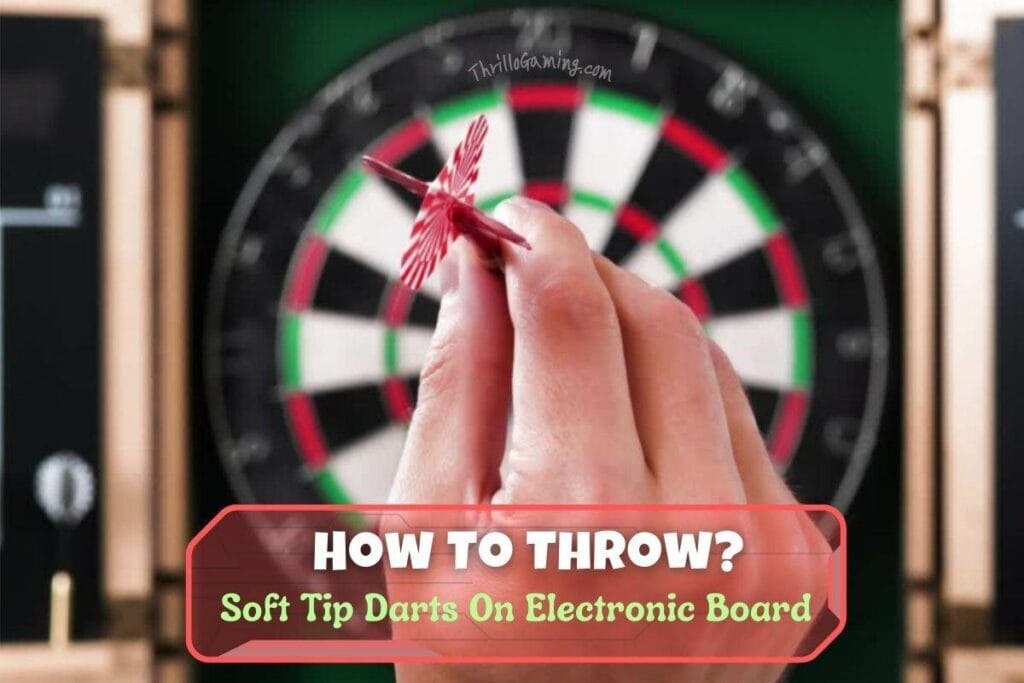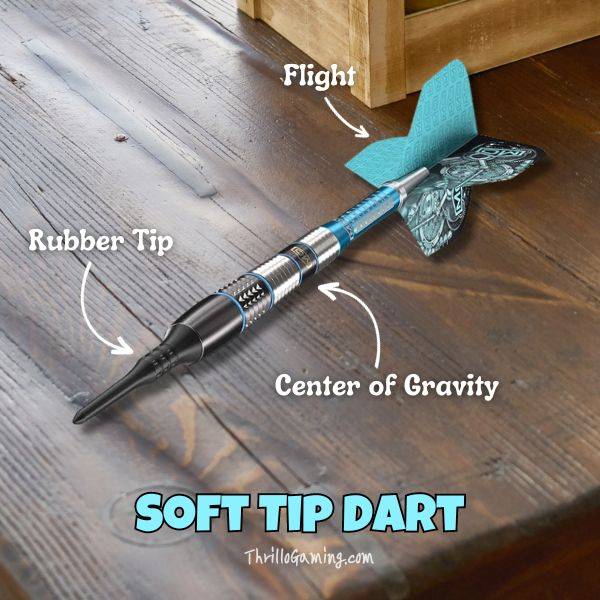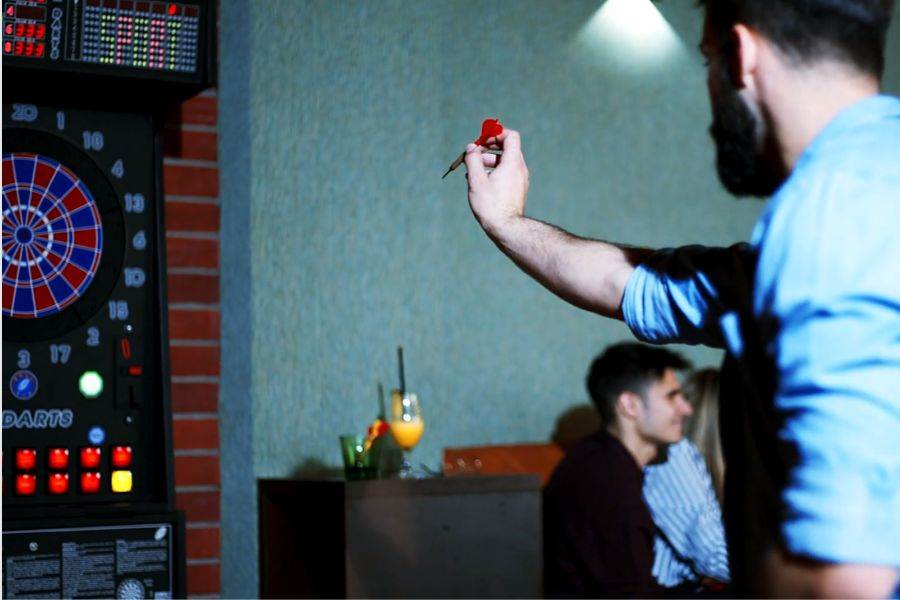Howdy fellow darts lovers! Let me tell you an interesting story today.
Three years back, when I walked into my local game arcade for my very first shot at electronic darts, my mind was buzzing with questions. You see, I’ve been a dart enthusiast since my childhood, and I’ve collected a bunch of dart boards over the years.
But this was uncharted territory – an electronic dartboard with soft-tip darts. As I picked up those new toys, the first question that struck me was: “Gee, do I launch these rubber-tipped darts in the same way as those old steel-tipped ones?”
Eventually, I played for years and mastered the art of throwing soft-tip darts. I’m sure you’ve been there too, grappling to find the right process. The good news is, it’s not very different from traditional darts!
While I needed some time to adjust to the lighter weight and a different feel, you don’t have to worry because I’m here to share my experience with you. If you’re eager to learn, let’s jump right in!

Step 1: Inspect The Soft-tip Darts
Getting a grip on the design and weight balance of your darts is crucial when it comes to winning at games. There’s a good reason why expert players are super picky about their dart selection – even tiny changes can mess with your aim.
For this reason, always choose the best soft-tip darts with the perfect balance of size, weight, and stability. If you’ve already got your gear sorted, let’s move on to the next step.
Step 2: Figuring Out The Center Of Gravity
Now, carefully examine your darts for any designated grip area – mine, for instance, has a ribbed section near the base of the tips. Next, experiment by delicately balancing the dart on a fingertip to locate its center of gravity.
This skill will prove invaluable in achieving a proper grip for improved accuracy. Be aware that soft-tip darts often have their center of gravity slightly towards the rear, in contrast to steel-tipped darts, owing to their lighter tips.

Step 3: Choosing Your Throwing Stance
Now, when it comes to setting up your electronic dartboard, remember that the ideal throw line distance is 8 feet. Stand behind this line in a way that allows you to aim and throw accurately. You’ve got a few stance options to choose from, so go with the one that suits you best.
The Side-On Stance: This is my personal favorite. Stand with your dominant foot in front, making a 90-degree angle with the dart board. Keep your front foot flat and shift your body weight toward the ball of your foot, using your rear leg for balance. Twist your hips to align your upper body with the dartboard, reducing the risk of overcompensating with your shoulder.
The 12 o’clock Stance: I found this stance worked well for my right-handed sister, who has a dominant left eye. In this stance, your dominant foot points directly at the electronic dart board, while your balance foot maintains a 45-degree angle. You may need to bring your head closer to your dominant arm or move your arm in front of your head in this stance, potentially involving some shoulder adjustment. Personally, I’m not a big fan of this one.
The Hybrid Stance: As the name suggests, the hybrid stance strikes a balance between the side-on and 12 o’clock stances. Place your dominant foot at a 45-degree angle to the dartboard and your balance foot at a 90-degree angle. Adjust your upper body and arm positioning to ensure a straight throw without overextending your shoulder.
Some players opt for a front-facing stance, with both feet side by side. However, I wouldn’t strongly recommend it, as it can affect your balance due to the upright center of gravity while throwing the soft-tip dart. Remember, there’s no one-size-fits-all stance; feel free to experiment with different styles to discover what works best for you.
Step 4: Gripping Your Soft-Tip Darts Properly
Mastering the art of holding your darts is like unlocking the secret to pinpoint accuracy in your throws. While you’re welcome to explore various techniques, allow me to share the two finest dart-gripping methods:
- Using Three Fingers: Most players, including me, hold a soft tip dart using three fingers. There are, again, several 3-finger grip techniques you could use. I initially used to hold them the same way everyone holds a pencil. However, I’ve discovered that the soft-tip darts are more consistent in their accuracy if I hold them at their center of gravity using my thumb and index finger while my middle finger supports the base of the tip from underneath.
- Using Four Fingers: If holding an electronic dart with three fingers feels too unstable, you could instead use four. Locate the center of balance with your index finger and support the position from above using your thumb. Meanwhile, the other fingers can support the dart lightly from the other side.

Step 5: Launching The Darts
Alright, now let’s get into the exciting part – throwing those soft-tip darts!
First off, relax. Don’t be all tense like a statue. Maintain a relaxed posture, releasing the tension from your body. Though it might be tempting, avoid leaning forward too much, as it will strain your back and hamper your stability. Throwing a dart is more than just a quick hand flick; it involves three distinct movements: the take-back, the release, and the follow-through.
- Take Back: This is the act of drawing the dart back. Move your arm back from your elbow, making a folding fan-shaped movement. Here’s a handy tip: position your hand so that your palm naturally points upwards. This will save your wrist from any strain.
- Release: As you might guess, this movement involves letting go of the dart. Imagine yourself throwing a paper plane – that’s pretty much how you release a soft-tip dart too. Avoid moving your elbow, and try to release all your fingers at the same time.
- Follow through: After releasing the dart, extend your arm naturally so that it ends with you pointing your fingertips towards the dartboard. While the movement you make after the release won’t affect the dart’s flight, this will help you build up the right motion for a straight trajectory.
Now, one more thing to remember – as soft-tip darts are lightweight, they feel easier to throw than steel-tipped ones. The first time I played on an electronic dart board, the difference in the weight and feel caught me a little off-guard. You should keep this in mind if you’re accustomed to regular bristle or wooden boards.
You can also watch this video to get a visual of the nooks and crannies:
Remember, there are no hard and fast rules when it comes to throwing electronic darts, besides, of course, the distance. Try out different stances and techniques to see which feels the most natural and comfortable for you.
From your posture to the flick of the wrist, every aspect matters a lot when playing with soft-tip darts. Once you’ve figured out the most suitable dart-throwing style for yourself, stick to it and practice it consistently to sharpen your skills.

